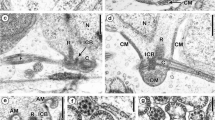Abstract
Polystoma australis oncomiracidia normally hatch after 10–11 days at 23‡ C and usually remain viable for up to 20 h. Retarded hatching sometimes occurred in normally developed eggs, and oncomiracidia which eventually hatched from these eggs often stopped swimming after a short time, but remained alive. Scanning electron-microscopic examination showed that they had lost their locomotory cilia but not the ciliary cells. This paper reports on the surface structure of the ciliary cells before and after the loss of cilia.
Similar content being viewed by others
References
Bychowsky BE (1957) Monogenetic Trematodes, their classification and phylogeny. Academy of Sciences USSR, Moscow. English translation by Hargis WJ, Oustinoff PC (1961) American Institute of Biological Sciences, Washington
Erasmus DA (1972) The biology of Trematodes. Edward Arnold Publishers, London
Kearn GC (1967) Experiments on host-finding and host-specificity in the monogenean skin parasite Entobdella soleae. Parasitology 57:585–605
Kok DJ, Du Preez LH (1987) Polystoma australis (Monogenea): life cycle studies in experimental and natural infections of normal and substitute hosts. J Zool (Lond) 212:235–243
Lambert A (1981) Sensors and effectors in the behaviour of oncomiracidia: Ciliated epidermis and sensilla. In: Biology of monogeneans, Workshop no 4. Parasitology 82:57–68
Llewellyn J (1963) Larvae and larval development of monogeneans. Adv Parasitol 1:287–326
Llewellyn J (1972) Behaviour of monogeneans. In: Canning EU, Wright CA (eds), Behavioural aspects of parasite transmission. Academic Press, London, pp 19–30
Maeder A (1973) Monogènes et Trematodes parasites d'amphibiens en CÔte-d'Ivoire. Rev Suisse Zool 80:267–322
Martin MF (1932) On the morphology and classification of Argulus (Crustacea). Proc Zool Soc Lond 102:771–806
Murith D (1981) Contribution à l'étude de la systématique des polystomes (Monogènes, Polystomatidae) parasites d'amphibiens anoures de basse CÔte-d'Ivoire. Rev. Suisse Zool 88:475–533
Tinsley RC (1976) Oncomiracidial morphology and evolutionary relationships within the Polystomatidae (Monogenoidea). Parasitology 73:XXV
Tinsley RC (1981) The evidence from parasite relationships for the evolutionary status of Xenopus (Anura Pipidae). Monit Zool Ital (NS) Suppl 15:367–385
Tinsley RC, Earle CM (1983) Invasion of vertebrate lungs by the polystomatid monogeneans Pseudodiplorchis americanus and Neodiplorchis scaphiopodis. Parasitology 86:501–517
Tinsley RC, Owen RW (1975) Studies on the biology of Protopolystoma xenopodis (Monogenoidea): the oncomiracidium and life-cycle. Parasitology 71:445–463
Author information
Authors and Affiliations
Rights and permissions
About this article
Cite this article
du Preez, L.H., Kok, D.J. Polystoma australis (Monogenea): loss of locomotory cilia associated with retarded hatching of oncomiracidia. Parasitol Res 74, 50–54 (1987). https://doi.org/10.1007/BF00534932
Accepted:
Issue Date:
DOI: https://doi.org/10.1007/BF00534932




